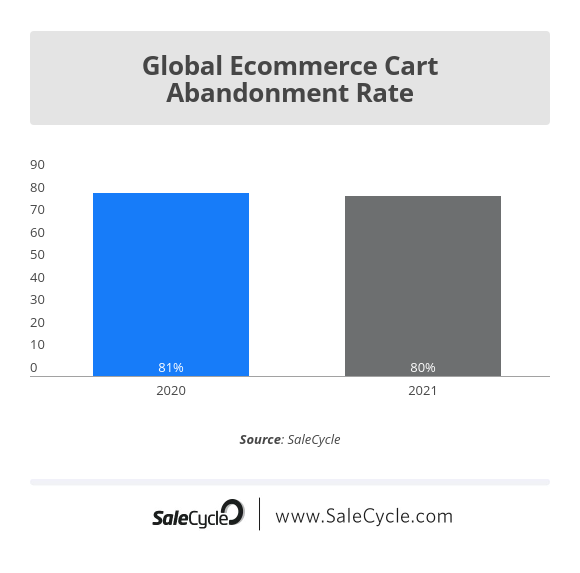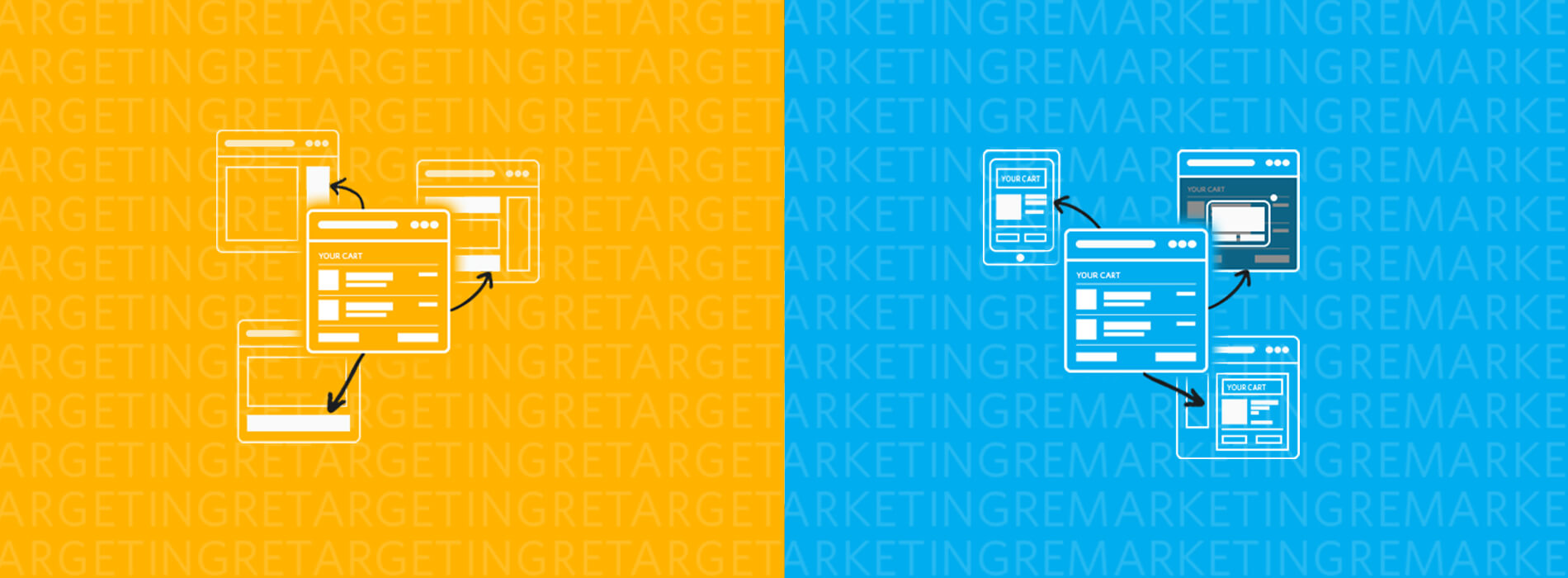Cart abandonment can pose a challenge for online businesses. Our latest abandonment stats from our 2022 Ecommerce Stats & Trends Report show that around 80% of people who add an item to their shopping cart don’t complete their purchase in that session.
In this article, SaleCycle highlights the importance of fine-tuned retargeting and remarketing and explores core principles alongside key ecommerce statistics to help you make improvements to your current strategy.
Table of Contents
Why Is Cart Abandonment Retargeting & Remarketing ImportantWhat’s The Difference Between Cart Abandonment Retargeting & Remarketing
What Is Cart Abandonment Remarketing
4 Examples of Abandonment Remarketing & Retargeting
Why Is Cart Abandonment Retargeting & Remarketing Important?
First of all, it’s important to highlight that with every website visit only a certain percentage of visitors will actually commit to a purchase or are browsing with no intention to buy at all, causing high rates of browse abandonment and/ or shopping cart abandonment. In these recent findings compared to the previous two years (stats below), we can see that the Global Ecommerce Cart Abandonment Rate is an average of around 80% – a massive percentage of visitors without considering the standard customer journey.
However, for the majority of the people who abandon your website, they are in turn showing an interest in your products in general, or specific items they may have browsed.
This kind behavioural data allow marketers to gain insights into their customer’s minds, which makes for more effective cart abandonment retargeting or remarking campaigns and tools like browse abandonment emails. It’s why so many brands use remarketing and retargeting campaigns to reconnect with people who haven’t purchased yet.


What’s The Difference Between Cart Abandonment Retargeting & Remarketing?
There are a variety of retargeting and remarketing channels, including: email, ads, digital display and so on. However, in the area of cart abandonment both retargeting and remarketing holds the same aim, and can therefore be put into practice across similar channels. Both terms refer to the targeting of shoppers who abandon purchases, using data and behavioural segmentation from their site visit.
One understanding is that retargeting refers to the use of display ads to visitors along with third party cookies, while remarketing is usually carried out via email marketing.
We’re about to explore the question what is remarketing further, to explore the subtle differences between remarketing and retargeting.
What Is Cart Abandonment Remarketing
To re-emphasise – retargeting or remarketing is the process of re-engaging with visitors to your website who show an interest in your products, service or solution.
The basic premise is that having spent a countless amount of time, money and effort to attract visitors to your website, it makes sense to engage the 95-99% who don’t convert on that visit (stats below). The users have entered your site for a reason and have shown interest in what your website offers, even just by clicking into the site.


4 Examples of Abandonment Remarketing & Retargeting
Now that we can grasp the concept of cart abandonment remarketing and retargeting, we can explore the ways in which we can use different strategies and tools to capture successful website visits.
Below are 4 different examples and marketing channels that webmasters and marketers use to reconnect and recover lost online sales for you to utilise in your next campaign or sales period.
Display Remarketing (and / or Display Retargeting)
Display remarketing is the process of showing ads to people who have visited your website and leave without buying. These shoppers can be shown display ads showing the product viewed, sometimes with a discount or special offer, to tempt the customer back to the site.
A good example can be found in the online travel industry, displayed here by Virgin Atlantic. The brand uses this clever display tactic, and visitors who have left without booking are shown ads on third party websites which are viewed later to remind the consumer about their previous visit to overall avoid booking abandonment.


Banner/display ads have gained a bad reputation, and they don’t always perform well but retargeting increases their effectiveness, thanks to the relevance of the product shown to the person viewing the ad.
The average click through rate for display ads is around 0.07%. For retargeted ads, it’s 0.7%.
Remarketing Abandoned Cart Emails
Email remarketing is the process of reconnecting with someone via email, once they have abandoned your website.
The most common use-case is cart abandonment emails, providing a handy route back to customers who add items to their shopping cart and then leave without completing their purchase. The concept works equally well for non-traditional shopping carts too, be it an abandoned credit card form, or abandoned bookings.
Sent around an hour after a booking is abandoned, it reminds customers that they are ‘so close’ to finishing their booking and makes it as easy as possible for them to secure their seat.
With a 59% open rate and $29 generated from every single email sent, these are not your average fire and forget bulk email send.


On-Site Remarketing (and / or On-Site Retargeting)
On-site remarketing is the process of identifying or anticipating the moment someone is about to abandon while still on your website and displaying a message to either tempt them to stay and make purchase there and then, or to make it easier for them to come back in the future.
Triggered by mouse movements exiting the website frame (desktop) or a pre-defined idle time (tablets and mobile) the message you can see below tempts customers to either continue where they’ve left off – or enter their email address and receive a handy reminder for when it’s more convenient.


SMS Remarketing
Much like email retargeting, cart abandonment SMS targets shoppers who leave without completing a booking or purchase. The difference is that these messages are delivered by SMS. With so many people now wedded to their mobile phones, SMS is a highly responsive channel, which can out-perform email in terms of CTR.
SMS remarketing messages are opened within 90 seconds on average, compared to 90 minutes for email. These messages have an open rate of 98% with 90% of messages opened within three minutes.
By sending SMS messages 30 minutes after an abandoned booking, Thorpe Park increased its online sales by 5%.
32% of SMS recipients clicked on the messages, and almost 7% returned to complete their purchase.


In Summary
Cart Abandonment Retargeting and Remarketing, when done well, can achieve the same results through a variety marketing channels – from cart abandonment emails to website display techniques.
Whether you decide to call it remarketing or retargeting, the principle is the same. It’s all about capturing your visitors at the most effective time in their customer journey.
Speak to an expert
Learn how to convert your online audience into revenue with our experts.


Casey Turnbull
Casey is a Fashion Journalism graduate & ecommerce marketing executive at SaleCycle. Casey is committed to producing high quality content backed by in-depth research and data. She has experience developing content in a range of sectors including fashion, ecommerce and sports.








![Valentine’s Day Ecommerce Tips and Trends [2024 Strategy]](https://www.salecycle.com/wp-content/uploads/2019/01/valentines-ecommerce-1.png)




![How SaleCycle helped Vodafone increase their online sales by an additional 2,000 additional sales per month [Extended Version]](https://www.salecycle.com/wp-content/uploads/2023/08/vodafone-banner.webp)





